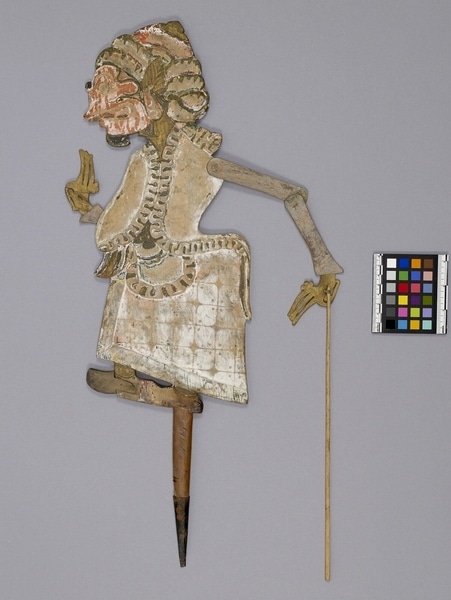Shadow Puppet Item Number: Ib270 from the MOA: University of British Columbia


Description
Puppet depicting a stylized, flat male figure with long handle that has a pointed metal tip at end. Parchment arms attached on either side of shoulder by string with control stick attached to one hand. Figure in three-quarter view. Songkok with red and gold cap shows traces of green, white, red and gold paint. Eyes round, long curling lips, moustache and small beard. Two rows of small teeth. Clothed in close-fitting long-sleeved jacket with carved ruffled edge and traces of red and yellow paint. Blue paint on apron. Sarong patterned with white in checkered motif, traces of red and green, with 1.6 cm border along bottom and front showing traces of blue and gold paint. Three-fingered gold hands held with wrists flexed. Legs are gold, held close together. Clog-like shoes with remains of red paint.
History Of Use
Javanese puppetry as an art form probably developed by the 11th century. The two dimensional wooden wayang keruchil puppets are a later development of the earlier and sacred wayang kulit shadow plays puppets. Originally the plays depicted Javanese mythology, but after the Indian conquest of Java the Hindu epics, Ramayana and Mahabharata, were incorporated into the cycles, which comprise about 200 plays. An individual or group hires a dalang (puppet-master) to celebrate important occasions. The performances often last all night and are generally presented in three acts, with vocal and instrumental accompaniment. The individual plays vary widely in detail but usually involve conflict between good and evil. They serve a moral and religious purpose, and more recently, one of political commentary. Each puppet's character is represented by its appearance and placement onstage; protagonists with strong elements of good are placed to the right, antagonists of violent or evil nature to the left. Most plays are based on the Mahabharata theme of conflict between the Pandawa and the evil Kurawa families. The main Hindu gods - Vishnu, Shiva, and Brahma - do not normally appear in the plays, but use a group of lesser deities, betara, as agents. These deities and resi appear in the retinues of both sides. Betara Narada provides information to players not otherwise available. Although he appears on the right, his actions are not necessarily in the interests of the Pandawas. Narada is an aspect of Shiva.
Iconographic Meaning
Songkok (spiral headdress with hanging neck cloth), lack of armbands, anklets, and shoes identify this figure as a deity (betara) or priest (resi). Rose colour, wide nose, moustache, large upturned eyes, close fitting jacket and checked sarong are characteristic of the Betada Narada, a celestial messenger in the wayang purwa plays. Narada has a variable role, neither good nor evil. Rose face (anger) and upturned eyes (arrogance) are negative features.
Cultural Context
Theatrical performance.
Item History
- Made in Java, Indonesia
- Owned by Tradewind Antiques before March 15, 1983
- Received from Museum of Anthropology Shop Volunteers (Funding source) and Tradewind Antiques (Seller) on March 15, 1983
What
Who
- Culture
- Javanese
- Previous Owner
- Tradewind Antiques
- Received from
- Museum of Anthropology Shop Volunteers (Funding source) and Tradewind Antiques (Seller)
Where
- Holding Institution
- MOA: University of British Columbia
- Made in
- Java, Indonesia
When
- Ownership Date
- before March 15, 1983
- Acquisition Date
- on March 15, 1983
Other
- Condition
- poor
- Accession Number
- 0886/0004